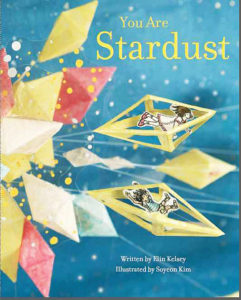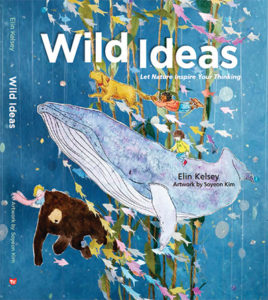Can Write: Meeting Canadian Writers and Illustrators of Children’s Books
What inspires the writers of the books your students read? How does an illustrator decide what to draw? Is it true that most authors and illustrators don’t know each other? This column features a different Canadian children’s book creator in each issue and shows you the story beyond the covers.
Meet Elin Kelsey, Environmentalist and Author
 The first book I heard by Elin Kelsey is called You Are Stardust. My grandson and I listened to the ebook version over and over. Her voice is hypnotisingly soothing. The story is brilliant. It explains our origins and our connection to nature in lovely, simple terms. The art in both the printed and electronic book is fascinating. I wanted to learned more about this author!
The first book I heard by Elin Kelsey is called You Are Stardust. My grandson and I listened to the ebook version over and over. Her voice is hypnotisingly soothing. The story is brilliant. It explains our origins and our connection to nature in lovely, simple terms. The art in both the printed and electronic book is fascinating. I wanted to learned more about this author!
Margriet: You are an environmentalist with a science degree. How did you get into writing for children?
Elin: I always had a passion for connecting people with the extraordinary ways in which animals communicate, have cultures, innovate and create. As a science student, I discovered that I was a better bartender than lab student because I loved to share stories with people. I volunteered at the Toronto Zoo by writing for the zoo’s education department. That led to my first book contract for a kids’ book series on animals. I went on to get a PhD and became an environmental communicator working on projects all over the world, but I have always continued to write for children.
Margriet: What role did teachers play in making you into the person you are today?
Elin: I had a wonderful grade five teacher who gave us opportunities to write. One day she handed back an assignment and said, “You are going to be a writer.” It thrilled me, and gave me the confidence to get my work published when I was very young.
Margriet: Kids always ask, “How do you get your ideas?” How do you decide which idea will make a good book for children?
Elin: I spend a lot of time talking with scientists and keeping track of new trends. I think kids should have access to the newest ideas rather than a rehashing of “facts” that we often find in non-fiction books. When I heard that scientists were discovering more new species now than at any other time in history, I wrote Strange New Species, a book about why and how so many species are currently being identified. I also study how kids feel about the environment. When I learned that many kids all over the world feel overwhelmed by the doom and gloom messages they hear about the environment, I set out to write a hopeful book about the environment. Not Your Typical Book About the Environment won the international Green Earth Book Award.
Margriet: Tell me about the process you went through with You Are Stardust.
 Elin: Lots of people are concerned that children are increasingly disconnected from nature. This may be because adults are afraid to let them explore, or they live in cities where it is harder to find green spaces or spend a lot of time looking at screens or they are so busy, they don’t have time to play outside. I share those worries, but I also think it is important to remember that kids are nature. No matter whether they—or we—are sitting in a car seat or flying in an airplane, our lives are intimately connected to the natural world.
Elin: Lots of people are concerned that children are increasingly disconnected from nature. This may be because adults are afraid to let them explore, or they live in cities where it is harder to find green spaces or spend a lot of time looking at screens or they are so busy, they don’t have time to play outside. I share those worries, but I also think it is important to remember that kids are nature. No matter whether they—or we—are sitting in a car seat or flying in an airplane, our lives are intimately connected to the natural world.
I collected examples of these connections. How every time a child blows a kiss to the world, for example, she exhales pollen that might grow to be a flower—that sort of thing. I originally wrote these examples as a chapter in Not Your Typical Book About the Environment. But a great editor looked at an early draft and said, “This would make a wonderful picture book.” I had never written a picture book so it took me a while to realize that it was better to write a book that encouraged young children to explore the wonder of that connection, rather than provide them with the scientific explanations of those things. It was a great lesson for me as an environmental writer—continuing to gather the scientific explanations from scientists and then learning how to take out any details that might get in the way of kids engaging with the wonder of the ideas.
Margriet: Have you met the illustrator of this book, Soyeon Kim?
Elin: Many writers and illustrators never meet each other. The editor decides which illustrator fits the style of the book the author has written. That way illustrators are free to follow their own interpretation of the text. But I was lucky enough to meet Soyeon Kim several times. I love the ephemeral quality of her work: how she dries flowers from her garden to use in the dioramas. How she takes a concept as astronomically big as the fact that we all started life as stardust and creates a piece of art that feels intimate enough to fit in a picture book that a child might read in bed.
Margriet: What’s next for you?
Elin: I am involved in projects to move the environmental narrative beyond doom and gloom toward hope, by connecting kids and adults with the conservation solutions and successes that are happening all over the planet.
In 2014, I co-hosted a gathering of conservation scientists, communicators and new media designers in London, England. We challenged ourselves to create a social change project to engage people with ocean conservation successes. We set about to populate and crowd share stories about marine conservation solutions by focusing on World Oceans Day, an international event scheduled for June 8, 2014 (just two weeks after the workshop). We invented a #OceanOptimism hashtag and encouraged others to share conservation successes.
The tag went viral. In less than a year-and-a-half, #OceanOptimism has been seen by over 50 million Twitter users. Huffington Post with its 6.3 million followers and the World Bank with its 1.58 million followers now use #OceanOptimism. I am writing a book about hope and the environment for adults. I also host a podcast series with international researchers to help replicate environmental successes. Happy to report that in the past decade, ten “big ocean” conservation areas, each of them larger than 100,000 km2, have been established around the world.
I want to help parents and educators nurture the resilience of kids, embolden them with the knowledge that conservation solutions are happening all over the world, instil children with a sense of purpose, connections and belief in their capacity to effect change.
Margriet: Do you do school presentations? What do these look like?
 Elin: I do lots of public and school talks: large assemblies or small classroom visits. I want to help kids realize that problem solving is just a normal part of life whether you are an octopus or a 2nd grader or a hyena. That is one of the reasons I wrote Wild Ideas. I was eager to show them the creative ways in which animals solve problems, and how it might spark ideas in their own lives. I also work with students in middle and high school, writing about their feelings towards the environment. I help them to recognize dominant narratives that shape our lives—like the narrative of doom and gloom that characterizes so much of what we hear about the environment—and to critically analyze the assumptions upon which these narratives are based. In our noble zeal to educate kids about very real and urgent environmental problems, we are inadvertently creating a generation that feels hopeless about the future of the planet. And that is something that I am determined to change.
Elin: I do lots of public and school talks: large assemblies or small classroom visits. I want to help kids realize that problem solving is just a normal part of life whether you are an octopus or a 2nd grader or a hyena. That is one of the reasons I wrote Wild Ideas. I was eager to show them the creative ways in which animals solve problems, and how it might spark ideas in their own lives. I also work with students in middle and high school, writing about their feelings towards the environment. I help them to recognize dominant narratives that shape our lives—like the narrative of doom and gloom that characterizes so much of what we hear about the environment—and to critically analyze the assumptions upon which these narratives are based. In our noble zeal to educate kids about very real and urgent environmental problems, we are inadvertently creating a generation that feels hopeless about the future of the planet. And that is something that I am determined to change.
Website: elinkelsey.org
For more details, podcasts and activities, check: owlkidsbooks.com/wildideas
ABOUT THE AUTHOR
Margriet Ruurs
Margriet Ruurs is the author of 28 books for children. She conducts author presentations in schools around the country. margrietruurs.com
This article is from Canadian Teacher Magazine’s Jan/Feb 2016 issue.











